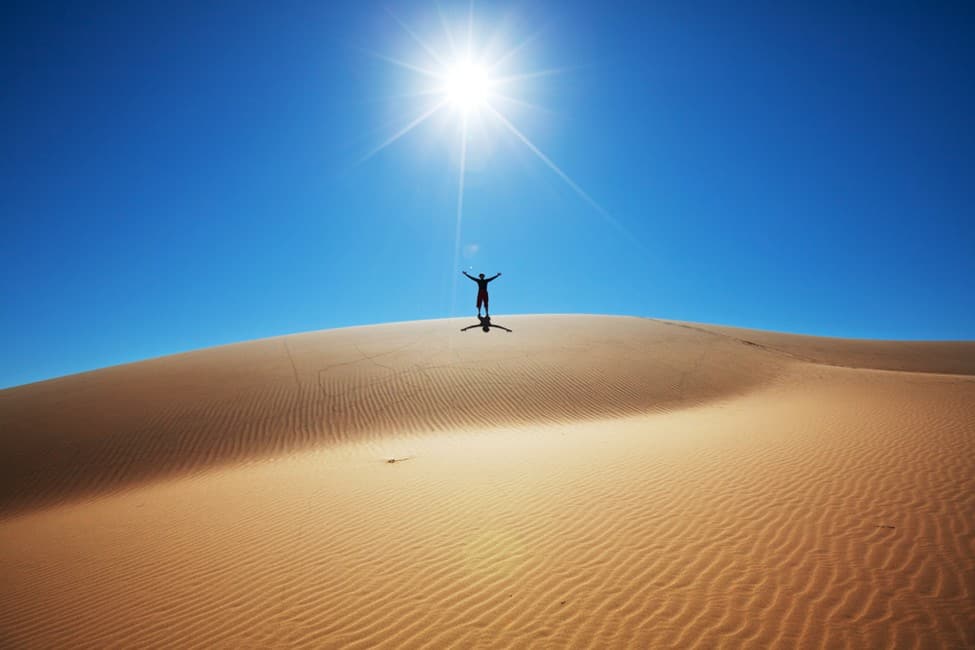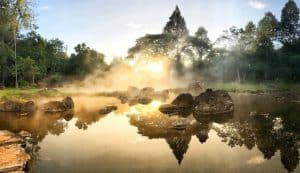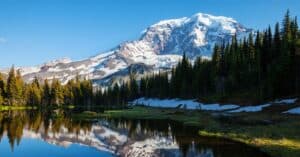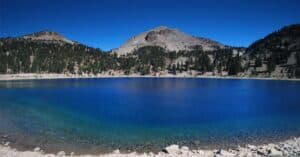Last Updated on April 17, 2025 by Aswetravel
Great Sand Dunes National Park Camping – Mention Colorado and what comes to mind is probably the magnificent Rocky Mountains and popular skiing destinations. You’ll have the time of your life touring popular towns if you’re a ski enthusiast.
What you might not think of is Great Sand Dunes National Park. The dunes formed 440,000 years ago and Great Sand Dunes National Park and Preserve was formed to preserve and add to Colorado’s rich history. At Great Sand Dunes Park, you can enjoy sand sledding, sandboarding, and more.
In this article, you’ll discover this breathtaking destination in southern Colorado and learn what you can do to get the most out of your camping trip here.
Let’s dive right in.
Why Visit Great Sand Dunes National Park?
You don’t encounter dunes like this every day. They’re a rare occurrence that carry a fascinating cloud of mystery and wondrous beauty.
But there’s something about Great Sand Dunes National Park that makes them even more attractive: the rich history of the dunes. The park is surrounded by scenic views, too, including the Luis Valley, the Sangre de Cristo Mountains on the east, and Juan Mountains on the west.
Inside the park, you’ll be in awe of the breathtaking diversity. Among the high desert landscapes are meadows, shrublands, pine forests, wetlands, and grasslands. There are over 100 acres to explore.
The park was recently named one of the most serene and quietest park in the National Park System. In short, the Great Sand Dunes National Park and Preserve is a place of contrasts that no amount of words can capture.
Find your way there to see and experience this park for yourself.

Camping at the Great Sand Dunes National Park
Here are some of the camping grounds available in the park and what makes each one stand out.
1. Piñon Flats Campground
Piñon Flats Campground is the only developed campground in the park, making it the most preferred site for people who camp here. Another reason Piñon Flats is a favorite is that it has great views of the surrounding scenery.
You can choose to pitch a tent in the open areas, inside the forest, or position your tent near the trails leading to the dunes. If you’re up for it, you also have the option to move into the backcountry for an even more adventurous experience.
Regulations at Piñon Flats Campground
- Some sites host a maximum of 2 tents, 8 people, and 2 vehicles, and some small sites can only accommodate one car and one tent. Keep this in mind as you make reservations according to the size of your group.
- Your vehicle has to fit into the driveway, and the tent must fit onto the tent pad.
- The latest time to check out is 1:00 pm.
- Generator hours run from 7:00 am to 8:00 pm while quiet time starts at 10:00 pm and ends at 6:00 am.
- Although you can bring along your pet, you need to ensure that you attend to it all the time. In other words, you shouldn’t let the pet wander all over camp without supervision.
- The camp has three sites for groups available at $65 or $80, depending on the size and amenities.
- Management doesn’t allow the use of hammocks.
- You must always clean and take care of your waste during your stay. Littering is an issue as the camp expects you to cooperate in keeping the place clean.
- Keep your food tightly sealed and beyond reach as bears frequently visit the site. Black bears also like scented items, so be sure to keep those at bay.
- Do not feed the wild animals, even those that come to the campsite.
- Make a reservation for the campsite early, especially during busy seasons. The park gets busiest from late May to early June.
2. Medano Pass Primitive Road
The Medano Pass Primitive Road is ideal for people with a thing for camping in primitive conditions. There’s little to no development here, so it’s a good idea to double-check the specifics before camping here.
Medano Pass Road only works if you’ve got a high-clearance 4WD vehicle; otherwise, you’ll get stuck in the middle of nowhere. Before venturing into the site, check with rangers so that you get the latest update on whether or not the area is passable.
Medano Pass Primitive Road also crosses the Medano Creeks nine times. You must check online or with the National Park Service rangers to find out the latest creek levels before heading out.
Medano Pass Primitive Road Precautions
The road is 22 miles and one of the toughest in the entire park, the kind of road that makes the ultimate adventure.
This is the only access point to the Great Sand Dunes National Preserve by car. The same road reaches Medano Pass at 10,000 ft during favorable weather conditions, so the drive will take between 2.5 and 3 hours.
Reduce your tire pressure to 20 psi when the sand is soft and dry. You can access an air station on the southern entrance from 7:00 am to 7:00 pm.
It’s a good idea to bring an air compressor so you don’t risk getting stuck in Medano Canyon. Remember to reinflate before driving into the rocky parts of the pass.
Another pro tip is to drive through the crossing at a slow speed; otherwise, you might end up drowning your engine.
Rules for the Medano Pass Road Campsites
- A 4WD vehicle is a must to navigate the road leading to the camping sites safely.
- UTVs, ATVs, and off-road driving aren’t allowed in this area.
- The management only allows motorcycles registered as OHVs to drive through Medano Pass.
- You can only light a fire in the fire rings provided by park management.
- You’ll have access to bear boxes you can use to store your foods and other scented items so that they’re out of reach for the bears.
- You can bring your pet but ensure it remains on a leash and restrained throughout your stay.
- You can only camp within the 21 designated locations. In other words, you can’t just head out into the wilderness and set up camp wherever you want.
- The road is closed in November for winter and re-opens in late May, depending on the weather conditions.
- Ensure you pack out all your trash and that you leave your campsite better than you found it.

3. Backcountry Camping
Backcountry is another choice, especially if the other sites are filled. This campsite isn’t ideal for first-time campers with no experience with this kind of camping. This site is an excellent option if the harsh conditions of backcountry wilderness camping are part of the fun you and your team loves.
You need to prepare adequately and bring along everything you need to make your stay here worthwhile. Below are some things to remember if you’re planning to camp here.
- The fee is $6, which covers backcountry camping permits.
- Bring all the necessary gear you need, including sufficient clothing, cookware, pads, water purification tablets, and sleeping bags.
- You can choose between the seven designated campsites and 20 undesignated ones in the backcountry Dunes.
- Keep your food safely away from the bears that frequent the camping sites.
- Children are welcome, but keep a close eye on them.
- Don’t leave your trash behind when it’s time to go.
When to Visit
You’re welcome to visit the park any time of the year. However, it tends to get hot and crowded during summer.
During the hottest months, the sand surface temperatures can go as high as 150°F. The frequency of thunderstorms also tends to intensify during summertime. During this period, you can still enjoy the park in the evenings or early mornings.
Early fall is the ideal time to visit the park as the temperatures are usually mild. However, if you have a low tolerance to intense temperatures, you can plan to visit during fall and spring. These two seasons have the most comfortable temperatures, but they can get quite windy, especially during March and April.
The Great Sand Dunes National Park has fascinating events and programs between March and September of every year. The area remains mostly sunny during the winter season, so it’s still a great time to visit.
Where to Stay
Piñon Flats Campground opens in April until the end of October. The site has a total of 88 non-hook-up sites and can accommodate RVs measuring up to 35ft. For the best experience, make reservations early.
The Great Sand Dunes National Preserve has the option of roadside camping along Medano Road, which has 21 designated sites.
If you’ve got a free backcountry ticket, you can also backpack in several hiking areas, but you’ll need to check with the rangers to see the various reserved for overnight backpacking.
The Great Sand Dune Oasis Campground is another alternative if you aren’t content with the available options. The site offers amenities such as full hook-up of RVs. You’ll also have a chance to explore the Zapata Falls Campground, which provides primitive camping.
Alternatively, you can also camp at the San Luis Lakes State Wildlife Area Campground located 15 miles from the western side of the Great Sand Dunes Visitor Center, but you need an annual access pass from Colorado Wildlife to enter.
Please note that you also need a license to fish and hunt in the area, but you do not need to make any reservations.
Other adventurous places include the Sand Dunes Swimming Pool and Campground, with an on-site geothermal pool and full hook-up sites.

How to Have the Best Experience at Great Sand Dunes
1. Take a map with you.
The area has flat and winding alpine passes, especially in rocky areas. Grab a map so that you minimize the risk of getting lost.
2. Pick a favorable season.
If you’re planning to visit Great Sand Dunes National Park and Preserve, you should first know that it sits at an elevation of 7,500ft. It is surrounded by rocky mountains and tends to get quite cold in late fall and early winter.
The best time to visit is during early summer or late spring when the weather conditions are the friendliest. Enjoy the cool waters of the creek cutting across the sand tunes when you visit in May or September.
If you are visiting in late summer, wear closed shoes to avoid getting your feet burnt in the bot sand.
3. Make reservations in advance.
Many people have discovered this hidden treasure and are now flocking to the park for an experience of a lifetime. To avoid disappointment, make reservations well in advance.
You can make reservations on recreation.gov to avoid any issues with last-minute booking.
4. Don’t forget your snacks.
Great Sand Dunes National Park and Preserve allows you to bring along your favorite snacks. Dogs can also come to have fun but are limited to only the Mosca Pass Trail and the Dunes Overlook Trail.
For the best experience for you and your dog, hike in the morning and evening.
5. Get a Jeep.
An RV will do just fine, but you can go the extra mile with a Jeep and have a more versatile and diversified experience. You can rent one from Pathfinders for a reasonable rate if you don’t have one of your own.
Plan Your Camping for the Great Sand Dunes
Great Sand Dunes National Park and Preserve is a perfect mix of everything you want in an adventurous camping experience, from the wetlands to dunes to forests to high peaks. There’s also off-road vehicle touring, backpacking, swimming, horseback riding, and more. Start planning for your camp at the Great Sand Dunes by making reservations today.
Stunning USA Self-Drive Tours and Adventures
Sunrise from Haleakala National Park
Things To Do In Kentucky
Things to Do in Hot Springs Arkansas
Best Time to Visit Shenandoah National Park
Green Mountain National Forest
Niagara Falls at Night




